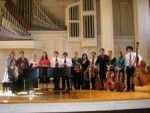A Tale of Two Violins

It was the best of concerts; it was the worst of concerts. Never in my experience have Dickens’s sentiments been more appropriate (in a musical context at least) than with regard to the concert given by the Colgate Chamber Players last Saturday, November 1. The Chamber Players, an assorted collection of students from all class years, were assisted by the musical guests Jill Timmons (piano) and Sarah Wider (cello), and directed by Professor of Music Laura Klugherz in their first show of the season. The performance, which featured works ranging from Mozart to Toldrá, Boccherini to Brahms, illustrated to what heights a talented string ensemble can soar.
Anyone who knows me is cognizant of my ever-so-slight aversion to string instruments (an aversion cultured by extensive exposure to squeaky and perpetually sharp amateur violinists). As a French horn player, however, I also understand the difficulty in getting and keeping your instrument in tune; there’s an old orchestral joke that asks, “How do you get the viola section to sound like the horns? Have them play every other note flat.”
Regardless, the disagreement in pitches among the players in both Schubert’s “Adagio in Eb Major, ‘Notturno,'” and Haydn’s “Trio in G Major, no.1” was distracting enough that I could barely focus on any other characteristics in the music. I’m sure that part of the cause stemmed from nervousness (especially because this was quite early in the concert), but that doesn’t change the fact that Haydn did not intend for his violin players to play in quarter-tones. The one shining exception to these problems was the cool and collected playing of sophomore Caroline Heaney; she handled herself at the piano bench with excellent poise in the Notturno.
I’m sure at this point in my article I’ve angered the whole collective of string players on campus (except maybe the violists, who are used to this type of abuse). There is a rationale behind my cruelty, however. If the Chamber Players hadn’t shown excellent musicianship in other works, I wouldn’t be inclined to set such a high bar. Especially noteworthy was a piece sandwiched between the Schubert and Haydn in the concert: Boccherini’s “Quintet no.2 in C Major” for two violins, viola, bass and guitar. This work, which paints a picture of the night watchmen traversing the city of Madrid, started out shaky, but first violinist and sophomore Stephanie O’Brien regained her composure and gradually led the group on an increasingly energetic romp through the city streets. While this piece didn’t quite reach the polish of later works (all the music hitherto described except the Schubert was performed by students alone), the emotion and enthusiasm infused into the performance by the Chamber Players was delightful. And, as the night watchmen faded back away into the distance, I was indeed sorry to see them go.
The passion infused in Boccherini’s music by the Chamber Players was repeated only one other time in Saturday’s concert: during the presentation of Eduardo Toldrá’s “Vistas al Mar.” The lively dance melodies, influenced by both Catalan folk music and the poetry of the Spaniard Joan Maragall, clearly inspired the Chamber Players (or perhaps it was the presence of their director, sitting in the midst of the action for this piece). Whatever the cause, while Toldrá’s writing style was not as traditional or lyrical as his predecessor Boccherini, there’s no doubt that the Chamber Players played it with equal zeal (especially first-year Myung Jin Lee, whose impassioned pizzicati could be heard all the way across the Quad).
After the contributions from the Spanish composers (or in Boccherini’s case, semi-Spanish), the focus of the concert moved back to Austria for performances of Mozart’s “Piano Quartet no.1 in g minor” and Brahms’s “Sextet no.1 in Bb Major.” Unlike the earlier works, the Quartet and Sextet sounded very polished and professional (mostly because of Laura Klugherz; for better or worse her playing dominated the group whenever she held a bow in her hand). One would think that after the incessant griping about squeaky and downright bad notes that I would welcome this new development, but for some reason the music fell a bit flat on my ears. While the incidences of my wincing did decrease dramatically, the music also lacked that certain raw, unrefined enthusiasm of students still learning how to experiment with the emotions of audience members.
In the end, while there were certainly some rough patches on Saturday, there were also very musical moments. As the afternoon progressed and the Players became more relaxed and confident, the quality of their music improved. I’ve been trying very hard (evidently with little success) not to compare the Chamber Players to any of the professional groups that perform at Colgate. By viewing the Players instead as ordinary students who play music simply for the love of it, the concert takes on a whole new meaning. Besides, there was a sense of excitement and energy in the music that I’ve never heard in the performances of more “sophisticated” groups. I eagerly await listening to the growth of these musicians in their next concert.






